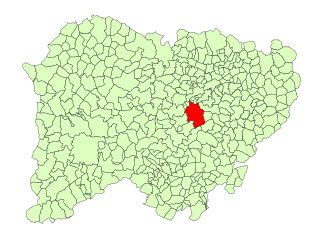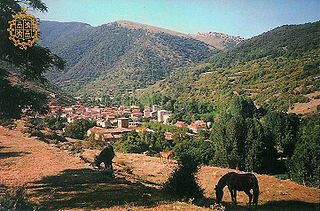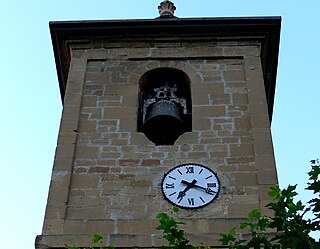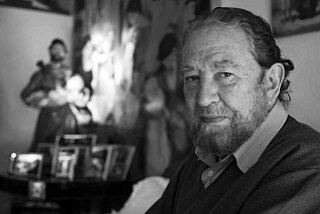
Calatayud is a municipality in the Province of Zaragoza, within Aragón, Spain, lying on the river Jalón, in the midst of the Sistema Ibérico mountain range. It is the second-largest town in the province after the capital, Zaragoza, and the largest town in Aragón other than the three provincial capitals. It is the seat of the comarca of Calatayud. Its population has been declining during the last decade due to migration.
Yécora is a town and municipality in the province of Álava, in the Basque Country, northern Spain.

Aljaraque is a city located in the province of Huelva, Spain. According to the 2016 census, the city has a population of 20,745 inhabitants. In ancient times it was referred to as "Kalathousa" by the Greeks.

Aldeadávila de la Ribera is a village and municipality in the north-west of the province of Salamanca, western Spain, part of the autonomous community of Castile and León.

Cetina is a municipality in the province of Zaragoza, Aragon. It is situated at an altitude of 666 metres (2,185 ft) in the south east of the province, in the Comunidad de Calatayud, some 176 kilometres (109 mi) north east of Madrid and 98 kilometres (61 mi) south west of Zaragoza. The population in 2011 was 687.

Alhama de Aragón is a spa town located in the province of Zaragoza, Aragon, Spain, situated on the river Jalón, a tributary of the Ebro. According to the 2004 census (INE), the municipality has a population of 1,150 inhabitants.

Ateca is a municipality located in the province of Zaragoza, Aragon, Spain. At the time of the 2015 census (INE), the municipality had a population of 1,969.

Chodes is a municipality in the province of Zaragoza, Aragon, Spain. As of 2007, Chodes had a population of 152. The municipality has an area of 16 square kilometers, and is along the Jalón River and the Isuela river.

Contamina is a municipality located in the province of Zaragoza, Aragón, Spain to the west of the Sierra de Padros, in the upper valley of the river Jalón, a tributary of the Ebro. According to the 2008 census, the municipality has a population of 42 inhabitants. In 1930 the population was 252. The 16th-century parish church is dedicated to St Bartholomew and is constructed in the baroque style. It has a notable 16th-century altar depicting the life of Saint Bartholomew in eight panels.

Yunquera de Henares is a municipality in the province of Guadalajara, Castile-La Mancha, Spain. As of January 2016, the population is 3,835 people, of which about 51% are men and 49% are women. The municipality is located about 80 km northeast of Madrid.

Zarzuela de Jadraque is a municipality located in the province of Guadalajara, Castile-La Mancha, Spain. The town is considered to be an example of "arquitectura negra" or "black architecture" due to the traditional use of slate and other local dark stones in constructing homes and walls. Zarzuela de Jadraque was also historically called "Zarzuela de las Ollas" or "Zarzuela of the Jars/Amphora" due to a tradition of producing hand thrown pots and amphora from an abundance of local clay. The original pottery kiln is still visible on the outskirts of the town. The town has one religious building, the church of San Clemente Romano, a Romanesque style church dating to the thirteenth century and built on the edge of enormous stone boulders. Other historic buildings include a town hall, communal outdoor laundry washing building, livestock and horse watering fountain and cemetery. According to the 2004 census (INE), the municipality has a population of 46 inhabitants although the population of the town swells in the summer and holiday months with descendants of past town dwellers who come to spend their vacations.

Puebla de San Medel is a municipality located in the province of Salamanca, Castile and León, Spain. As of 2016 the municipality has a population of 44 inhabitants.

San Martín del Castañar is a municipality located in the province of Salamanca, Castile and León, Spain. As of 2016 the municipality has a population of 226 inhabitants.

San Muñoz is a municipality located in the province of Salamanca, Castile and León, Spain. As of 2016 the municipality has a population of 253 inhabitants.

San Pedro de Rozados is a municipality located in the province of Salamanca, Castile and León, Spain. As of 2016 the municipality has a population of 307 inhabitants.

Berceo is a municipality in La Rioja, Spain. It is located near the monastery of San Millán de la Cogolla and was the birthplace of Gonzalo de Berceo. It has also been proposed as identification of historic Vergegio, named by Braulio of Zaragoza as the birthplace of Saint Millán, although present Berdejo in Aragon is another candidate.

Viniegra de Abajo is a municipality of La Rioja (Spain).

Morata de Jalón is a municipality located in the province of Zaragoza, Aragon, Spain.

Cihuri is a village in the province and autonomous community of La Rioja, Spain. The municipality covers an area of 9.76 square kilometres (3.77 sq mi) and as of 2011 had a population of 223 people.

Manuel Jalón Corominas was a Spanish air force officer, aeronautical engineer, inventor, and entrepreneur. He was awarded patents for improvements to the mop and the disposable syringe.






















